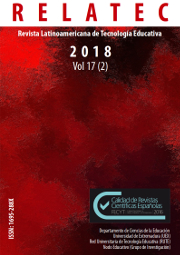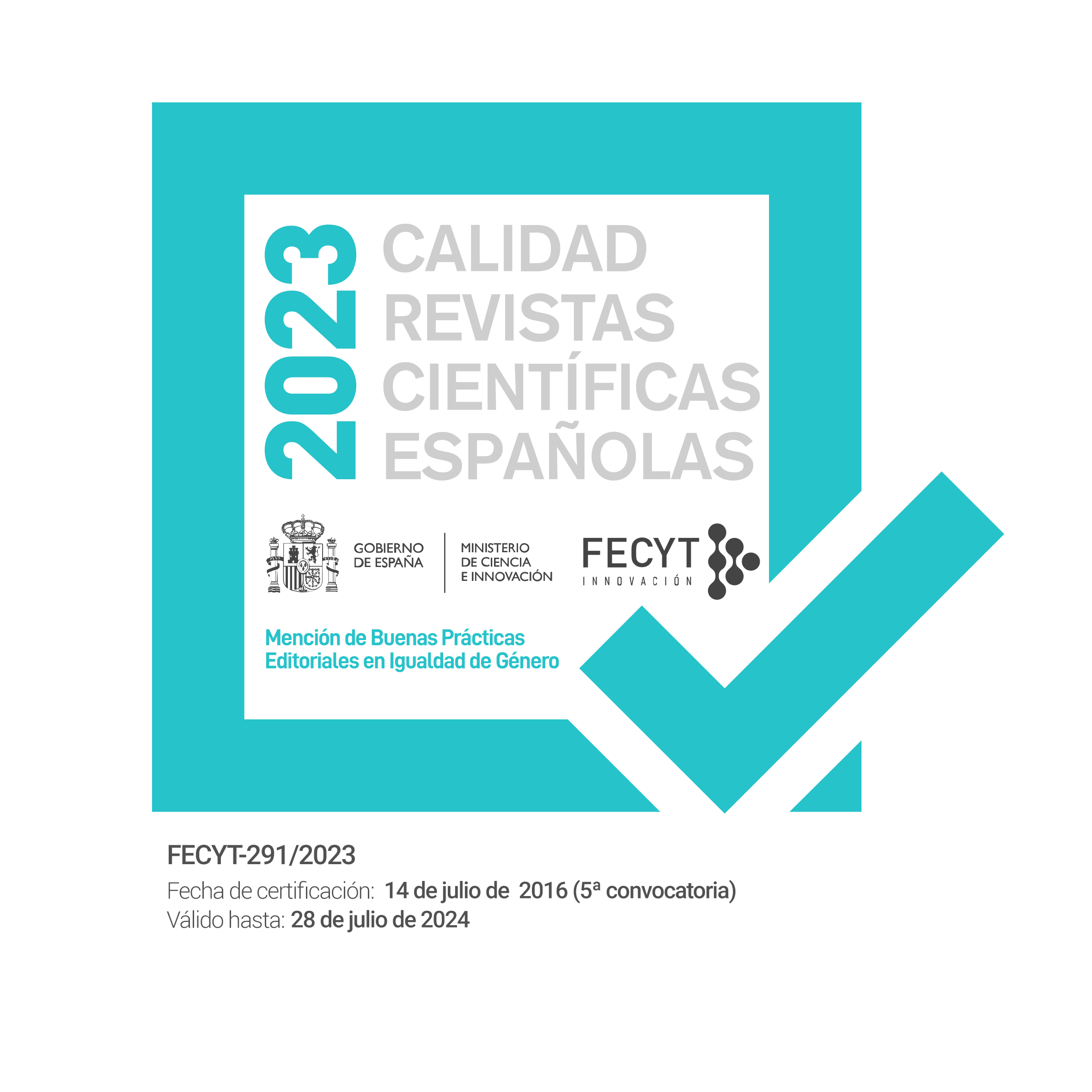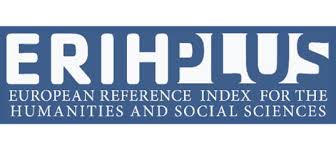Análisis longitudinal del desempeño académico de estudiantes de educación superior en un curso autónomo en línea
DOI:
https://doi.org/10.17398/1695-288X.17.2.101Palabras clave:
Aprendizaje en línea, Presencia social, Autogestión del aprendizaje, Educación SuperiorResumen
El E-learning implica autogestión del aprendizaje, cuando el entorno virtual exige un alto nivel de autonomía se puede prescindir de un docente porque los recursos tecno-educativos se auto operan para aprender. En estas condiciones, la ausencia de un docente/compañeros podría generar la percepción de aislamiento y favorecer resultados negativos en el aprendizaje. Por tanto, evaluar el papel de la presencia social en cursos con un alto nivel de autonomía es importante para describir cómo y en qué condiciones puede afectar el rendimiento de los estudiantes. El objetivo es comparar las calificaciones de dos grupos matriculados en un curso autónomo en línea; a uno se le aplicó una condición de «presencia social mínima» y el otro grupo fungió como control. Se ha aplicado un muestreo no aleatorio (n=137) y se utilizó un diseño factorial mixto 2x5. Los factores del diseño de investigación fueron «presencia social» y «tiempo»; se midieron las calificaciones del curso en cinco momentos diferentes; para analizar los datos se estimó un ANOVA factorial para diseños mixtos. Se evidenció que no existe interacción entre tiempo y presencia social, ni efectos principales de la presencia social sobre las calificaciones; sin embargo, el tiempo fue un factor significativo para explicar la varianza en las calificaciones. Estos resultados se discuten en términos de los alcances que pueden tener los cursos autónomos y el papel de la presencia social en condiciones de aprendizaje con un alto nivel de autonomía.
Referencias
Banerjeey, A., y Chaudhury, S. (2010). Statistics without tears: Populations and samples. Industrial Psychiatry Journal, 19(1), 60-65. doi:10.4103/0972-6748.77642
Beach, P. (2017). Self-directed online learning: A theoretical model for understanding elementary teachers' online learning experiences. Teaching and Teacher Education, 61, 60-72. doi: 10.1016/j.tate.2016.10.007.
Biocca, F. (1997). The cyborg’s dilemma: Progressive embodiment in virtual environments. Journal of Computer-Mediated Communication, 3(2). Recuperado de http://onlinelibrary.wiley.com/doi/10.1111/j.1083-6101.1997.tb00070.x/full doi:10.1111 / j.1083-6101.1997.tb00070.x
Biocca, F., Harms, C., y Burgoon, J. K. (2003). Toward a More Robust Theory and Measure of Social Presence: Review and Suggested Criteria. Presence: Teleoperators and Virtual Environments, 12(5), 456-480. doi:10.1162/105474603322761270
Cárdenas, M., y Arancibia, H. (2014). Potencia estadística y cálculo del tamaño del efecto en G*Power: complementos a las pruebas de significación estadística y su aplicación en Psicología. Salud & Sociedad, 5(2), 210-224.
Chi-Yang, J., Quadir, B., Chen, N., y Qiang M. (2016). Effects of online presence on learning performance in a blog-based online course. The Internet and Higher Education, 30, 11-20. doi:10.1016/j.iheduc.2016.04.002.
Driscoll, A., Jicha, K., Hunt, A., Tichavsky, L., y Thompson, G. (2012). Can Online Courses Deliver In-class Results? A Comparison of Student Performance and Satisfaction in an Online versus a Face-to-face Introductory Sociology Course. Teaching Sociology, 40(4) 312–331. doi:10.1177/0092055X12446624
Ekici, M., Coskun, I., y Yurdugul, H. (2014). Investigation of the Relationship between Learning Approaches and Online Self-regulation Behaviour. Procedia-Social and Behavioral Sciences, 141, 285-289. doi:10.1016/j.sbspro.2014.05.050.
Faul, F., Erdfelder, E., Lang, A., y Buchner, A. (2007). G*Power 3:A flexible statistical power analysis program for the social, behavioral, and biomedical sciences. Behavior Research Methods, 39 (2), 175-191. doi:10.3758/BF03193146
Faul, F., Erdfelder, E., Lang, A., y Buchner, A. (2009). Statistical power analyses using G*Power 3.1: Tests for correlation and regression analyses. Behavior Research Methods, 41(4), 1149-1160 doi:10.3758/BRM.41.4.1149
Field, A. (2005). Discovering Statistics Using SPSS (4th Edition). UK:Sage Publications.
Garrison, D. R., y Anderson, T. (2005). El elearning en el siglo XXI: Investigación y práctica. Barcelona, Octaedro.
Grusec. J. E., y Davidov, M. (2010). Integrating Different Perspectives on Socialization Theory and Research: A Domain-Specific Approach. Child Development, 81(3), 687-709.
Guarneros-Reyes, E., Espinoza-Zepeda, A., Silva, A., y Sánchez-Sordo, J. (2016). Diseño de un curso autogestivo modular en línea de metodología de la investigación para universitarios. Hamut’ay, 3(2), 7-24. doi:10.21503/hamu.v3i2.1305
Joksimović, S., Gašević, D., Kovanović, V., Riecke, B. E., y Hatala, M. (2015). Social presence in online discussions as a process predictor of academic performance. Journal of Computer Assisted Learning, 31, 638–654. doi:10.1111/jcal.12107.
Kadamy, P., y Bhalerao, S. (2010). Sample size calculation. International Journal for Ayurveda Research, 1(1), 55–57. doi: 10.4103/0974-7788.59946
Khanna, M., Badura-Brack, A., y Finken, L. (2013). Short- and Long-Term Effects of Cumulative Finals on Student Learning. Teaching of Psychology, 40(3), 175-182. doi:10.1177/0098628313487458
Khiat, H. (2017). Academic performance and the practice of self-directed learning: The adult student perspective. Journal of Further and Higher Education, 41(1), 44-59. doi:10.1080/0309877X.2015.1062849
Kim, J., Song, H., y Luo, W. (2016). Broadening the understanding of social presence: Implications and contributions to the mediated communication and online education. Computers in Human Behavior, 65, 672-679. doi:10.1016/j.chb.2016.07.009.
Kolb, D. (1984). Psicología de las organizaciones: experiencia. México: Prentice Hall.
Ladell-Thomas, J. (2012). Do-It-Yourself Information Literacy: Self-Directed Learning at a Distance. Journal of Library & Information Services in Distance Learning, 6(3-4), 376-386. doi:10.1080/1533290X.2012.705168
Lawrence, N. K. (2012). Cumulative Exams in the Introductory Psychology Course. Teaching of Psychology, 40(1) 15-19. doi:10.1177/0098628312465858
Liu, M. (2009). The design of a web‐based course for self‐directed learning. Campus-Wide Information Systems, 26 (2), 22-131. doi:2443/10.1108/10650740910946846
Liu, S. Y., Gomez, J., y Yen, C-J. (2009). Community college online course retention and final grade: Predictability of social presence. Journal of Interactive Online Learning, 8 (2), 165-182.
Markova, T., Glazkova, I., y Zaborova, E. (2017). Quality Issues of Online Distance Learning. Procedia-Social and Behavioral Sciences, 237, 685-691. doi:10.1016/j.sbspro.2017.02.043.
Mincey, K. (2015). Development of an Online Course in Public Health for Undergraduates. Pedagogy in Health Promotion: The Scholarship of Teaching and Learning, 1(1) 47–52. doi:10.1177/2373379914559219
Muñiz, J. (2010). Las teorías de los Tests: Teoría Clásica y Teoría de Respuesta a los Items. Papeles del Psicólogo, 31(1), 57-66.
Navarro, R. E. (2003). El rendimiento académico: concepto, investigación y desarrollo. Revista Electrónica Iberoamericana sobre Calidad, Eficacia y Cambios en Educación, 1(2), 1-15.
Ottewill, R. (2002a). Student self‐managed learning – time for action. On the Horizon, 10 (2), 13-14. doi: 2443/10.1108/10748120210440330
Ottewill, R. (2002b). Student self-managed learning cause for concern? On the Horizon, 10 (1),12-16. doi: 2443/10.1108/10748120210431358
Peckham, M. (1995). Self‐managed learning theory and practice. Management Development Review, 8 (4), 23-26. doi:10.1108/09622519510771924
Ponce, M. E. P. (2016). La autogestión para el aprendizaje en estudiantes de ambientes mediados por tecnología. Diálogos sobre educación, 7 (12), 1-23.
Reio, T. G., y Crim, S. J. (2013). Social Presence and Student Satisfaction as Predictors of Online Enrollment Intent. American Journal of Distance Education, 27(2), 122-133. doi:10.1080/08923647.2013.775801
Richardson, J. C., Maeda, Y., Lv, J., y Caskurlu, S. (2017). Social presence in relation to students' satisfaction and learning in the online environment: A meta-analysis. Computers in Human Behavior, 71, 402-417. doi:10.1016/j.chb.2017.02.001.
Sánchez, R., Vizcarra, B., Rosales, C. R., y Enríquez, D. (2017). Evaluación de la calidad de un curso en línea autogestivo. Revista Electrónica de Psicología Iztacala, 20(3), 1078-1102.
Shepherd, C. (2012) So What is eLearning?. In The Really Useful E-Learning Instruction Manual: Your toolkit for putting elearning into practice (ed R. Hubbard), John Wiley & Sons, Inc., Hoboken, NJ, USA. doi:10.1002/9781118375860.ch1
Shurville, S., y Brown, T. (2006). Introduction: ICT-driven change in higher education: Learning from e-learning. Journal of Organisational Transformation & Social Change, 3 (3), 245-250. doi:10.1386/jots.3.3.245_2
Silén, C., y Uhlin, L. (2008). Self-directed learning – a learning issue for students and faculty!. Teaching in Higher Education, 13(4), 461-475. doi:10.1080/13562510802169756
Song, D., Bonk, C., y Maree, R. (2016). Motivational factors in self-directed informal learning from online learning resources. Cogent Education, 3(1), 1-11. doi:10.1080/2331186X.2016.1205838
Sung, E., y Mayer, R. E. (2012). Five facets of social presence in online distance education. Computers in Human Behavior, 28 (5), 1738-1747. doi: 10.1016/j.chb.2012.04.014.
Swan, K. (2005). Social presence and E-Learning. Virtual Multi Conference on Computer Science and Information Systems. Recuperado de https://www.researchgate.net/profile/Karen_Swan3/publication/268378185_SOCIAL_PRESENCE_AND_E-LEARNING/links/553719a50cf268fd00188eb6/SOCIAL-PRESENCE-AND-E-LEARNING.pdf
Sze-yenga, F., y Raja-Hussain, F. M. (2010). Self-directed learning in a socioconstructivist learning environment. Procedia Social and Behavioral Sciences, 9, 1913–1917. doi:10.1016/j.sbspro.2010.12.423
Wang, J. y Antonenko, P. D. (2017). Instructor presence in instructional video: Effects on visual attention, recall, and perceived learning. Computers in Human Behavior, 71, 79-89. doi:10.1016/j.chb.2017.01.049.
Wayal, S., Bailey, J., Murray, E., Raint, G., Morris, R., Peacock, R., y Nazareth I. (2014). Interactive digital interventions for sexual health promotion: a systematic review and meta-analysis of randomised controlled trials, The Lancet, 384(2), S85. doi: 10.1016/S0140-6736(14)62211-X
Weidlich, J., y Bastiaens, T. J. (2017). Explaining social presence and the quality of online learning with the SIPS model. Computers in Human Behavior, 72, 479-487. doi:10.1016/j.chb.2017.03.016.
Wilcox, S. (1996). Fostering Self-Directed Learning in the University Setting. Studies in Higher Education, 21(2),165-176. doi:10.1080 / 03075079612331381338
Wilson, V. (2014). Research Methods: Sampling. Evidence Based Library and Information Practice, 9(2), 45-47.
Zarzosa, L., Luna, D., De Parrés, T., y Guarneros-Reyes, E. (2007). Efectividad de una interfaz para lectura estratégica en estudiantes universitarios. Un estudio exploratorio. Revista Electrónica de Investigación Educativa, 9 (2), 2-20.
Descargas
Publicado
Número
Sección
Licencia
Los autores/as que publiquen en esta revista aceptan las siguientes condiciones:
1. Los autores/as conservan los derechos de autor y ceden a la revista el derecho de la primera publicación, con el trabajo registrado con la licencia Creative Commons Reconocimiento-NoComercial-SinObraDerivada 4.0 International (CC BY-NC-ND), que permite a terceros utilizar lo publicado siempre que mencionen la autoría del trabajo y a la primera publicación en esta revista.
2. Los autores/as pueden realizar otros acuerdos contractuales independientes y adicionales para la distribución no exclusiva de la versión del artículo publicado en esta revista (p. ej., incluirlo en un repositorio institucional o publicarlo en un libro) siempre que indiquen claramente que el trabajo se publicó por primera vez en esta revista.
3. Se permite y recomienda a los autores/as a publicar su trabajo en Internet (por ejemplo en páginas institucionales o personales) antes y durante el proceso de revisión y publicación, ya que puede conducir a intercambios productivos y a una mayor y más rápida difusión del trabajo publicado (vea The Effect of Open Access).









